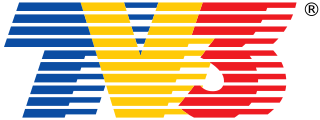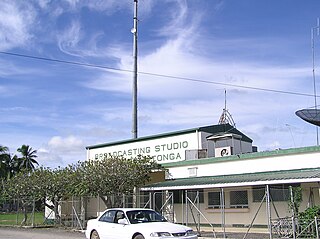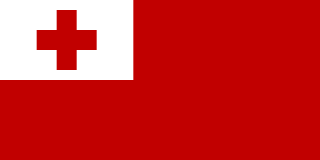Related Research Articles

NTSC is the first American standard for analog television, published in 1941. In 1961, it was assigned the designation System M. It is also known as EIA standard.

Terrestrial television or over-the-air television (OTA) is a type of television broadcasting in which the signal transmission occurs via radio waves from the terrestrial (Earth-based) transmitter of a TV station to a TV receiver having an antenna. The term terrestrial is more common in Europe and Latin America, while in Canada and the United States it is called over-the-air or simply broadcast. This type of TV broadcast is distinguished from newer technologies, such as satellite television, in which the signal is transmitted to the receiver from an overhead satellite; cable television, in which the signal is carried to the receiver through a cable; and Internet Protocol television, in which the signal is received over an Internet stream or on a network utilizing the Internet Protocol. Terrestrial television stations broadcast on television channels with frequencies between about 52 and 600 MHz in the VHF and UHF bands. Since radio waves in these bands travel by line of sight, reception is generally limited by the visual horizon to distances of 64–97 kilometres (40–60 mi), although under better conditions and with tropospheric ducting, signals can sometimes be received hundreds of kilometers distant.
Television broadcasting in Greece began in 1966, preceded in 1951 by statute 1963 permitting television broadcasting.

Television in New Zealand was introduced in 1960 as a state-run service. The broadcasting sector was deregulated in 1989, when the Government allowed competition to the state-owned Television New Zealand (TVNZ). There are currently three forms of broadcast television: a terrestrial (DVB-T) service provided by Freeview; as well as satellite (DVB-S) and internet streaming (IPTV) services provided nationwide by both Freeview and Sky.

Television New Zealand, more commonly referred to as TVNZ, is a television network that is broadcast throughout New Zealand and parts of the Pacific region. All of its currently-operating channels are free-to-air and commercially funded.

Virgin Media One, also called Virgin One, is an Irish free-to-air television channel owned by Virgin Media Ireland, operated through its subsidiary Virgin Media Television. The channel launched on 20 September 1998, as TV Three, becoming Ireland's fourth television channel and the first commercial channel. It was known as TV3 from 2006, and then as Virgin Media One from 30 August 2018. The channel broadcasts a mix of Irish programming and acquired programming from ITV and others.
8TV (Catalan pronunciation:[ˈbujtˈteˈβe]), formerly known as TD8 and then Citytv, was a Catalan language private TV station based in Barcelona, Spain. The channel was run by OC 2022. After a delay in the payment of its debts, it was closed on 17 October 2023.
Three, stylized as +HR=E, is a New Zealand nationwide television channel. Launched on 26 November 1989 as TV3, it was New Zealand's first privately owned television channel. The channel currently broadcasts nationally in digital free-to-air form via the state-owned Kordia on terrestrial and satellite. Vodafone also carries the channel for their cable subscribers in Wellington and Christchurch. It previously broadcast nationally on analogue television until that was switched off on 1 December 2013.

Sistem Televisyen Malaysia Berhad, operating as TV3, is a Malaysian free-to-air television channel owned by Malaysian media conglomerate, Media Prima. TV3 is the third oldest TV station in Malaysia. It was launched on 1 June 1984 as the country's first and oldest private television channel. As of October 2021, TV3 remains to be the most-watched television station in Malaysia with about 17% of its viewing share among other Malaysian television stations, followed by TV9 with 15% of its viewing share, making two of them become the second most-watched television station in the country, despite the declining viewership of 3 free-to-air television channels.

Independent Television Network Ltd also known as ITN Ltd or simply as ITN is a Sri Lankan state-governed television and radio broadcaster located in Wickramasinghepura, Battaramulla, Sri Lanka. It is a Shrama Abhimani Award winner , broadcasts content to a wide demographic within Sri Lanka as well as the expatriate community. The programmes are broadcast in three languages: Sinhala, Tamil, and English. The ITN broadcast coverage extends to 99% of the island of Sri Lanka.

Television Tonga is a Tongan television channel operated by the Tonga Broadcasting Commission. It was founded on July 4, 2000 by King Taufa'ahau Tupou IV.

The Omni Broadcasting Network was a small over-the-air broadcast television network in the United States. The company's motto was "Less Edge and More Entertaining". Omni's flagship station was low-power station KSSY-LP. The network's reach was reported as 50 million households, according to a quote in Variety.
Television in Latvia was first tested in 1937 and introduced in 1954. Latvia was the first country in the Baltic States which started broadcasting.
Television frequency allocation has evolved since the start of television in Australia in 1956, and later in New Zealand in 1960. There was no coordination between the national spectrum management authorities in either country to establish the frequency allocations. The management of the spectrum in both countries is largely the product of their economical and political situation. New Zealand didn't start to develop television service until 1965 due to World War 2 and its economic harm in the country's economy.

Christianity is the predominant religion in Tonga, with Methodists having the most adherents.

Virgin Media Television Ltd is a commercial television company in Ireland, based in Dublin. Launched in 1998 as TV3 Television Network, the TV3 Group was formed in January 2009. The company was acquired by Liberty Global in 2015, and the channels were rebranded to Virgin Media Television in 2018.

Television in North Korea is subject to the Korean Central Broadcasting Committee and controlled by the Propaganda and Agitation Department of the Workers' Party of Korea. A study in 2017 found that 98% of households had a television set. As of 2020, there are over-the-air broadcasts in both analogue and recently launched digital formats.
ASTL-TV3 was the second television station in the Kingdom of Tonga, which existed from 1984 to 1996. A subscription television service, later converted to a free-to-air television station upon the arrival of competition, it was broadcast over-the-air on channel 7.
VAP-TV18, also known as Vision of Pilolevu was a Tongan television channel owned by Siaosi Polutele Guttenbeil. The channel started terrestrial broadcasts in August 1983 in Nukuʻalofa being the first such television station in the country. Polutele had a three-hour-a-day - but not daily - schedule in what was considered to be a "do-it-yourself" format. Polutele had 20 years of experience in the field of television, working at television stations in New Zealand and as a TV repairman in the United States. The programming was entirely local: sports, news and current affairs. The television signal used by VAP-TV18 would reach a maximum of 100 television sets, aiming to cover the entirety of the island of Tongatapu. Startup costs for operation were estimated to be worth $10,000, with no charge to viewers, with the signal being entirely free-to-air. The station was supported by advertising, something a future competitor, ASTL-TV3, refused to carry until 1991.
References
- 1 2 Bentley, J.E.; Hermanson, D.; Rao, V.V. (September 1993). "PACIFIC REGIONAL TELEVISION SURVEY PROJECT – 352lRASl21 (PAC TEL)". UNESCO. Retrieved February 13, 2024.